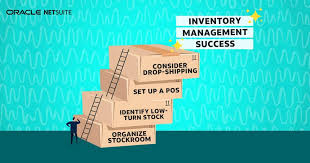Efficient inventory management for small business is at the heart of every successful company. Whether you’re running a retail shop, managing a warehouse, or selling products online, knowing exactly what’s in stock, what’s moving, and what needs replenishing can make or break profitability. Yet, many small businesses struggle with this essential task due to limited resources, manual tracking, or outdated systems.
In this guide, we’ll explore practical strategies for improving inventory management for small business owners. From choosing the right tools to adopting proven techniques, you’ll learn how to take control of your stock, minimize waste, and ultimately grow your business.
Why Inventory Management Matters for Small Business
Small businesses often operate on slim margins, which means excess stock, shortages, or errors can quickly eat into profits. Without clear visibility into inventory, challenges arise:
Overstocking ties up capital in unsold goods.
Stockouts lead to missed sales and frustrated customers.
Manual errors result in miscounts, confusion, and lost time.
Poor planning affects cash flow and business growth.
A solid inventory management strategy helps businesses avoid these pitfalls by offering accurate, real-time data that guides smarter decision-making.
Common Challenges in Small Business Inventory Control
Before diving into solutions, it’s important to recognize the challenges small businesses face:
Relying on spreadsheets or paper logs – prone to human error.
Limited staff resources – often one person wears many hats.
Inconsistent tracking methods – making reporting unreliable.
Seasonal demand fluctuations – leading to under- or over-ordering.
Difficulty forecasting – without proper data, predicting future demand is tough.
These challenges highlight the need for modern solutions tailored to the unique needs of small businesses.
Best Practices for Small Business Inventory Management
1. Use Inventory Management Software
Relying on spreadsheets or manual tracking may seem cost-effective at first, but it often leads to costly mistakes. A cloud-based system like Skyware Inventory allows small businesses to automate processes, track stock in real-time, and access reports from anywhere.
Key benefits include:
Automatic updates when sales or purchases occur.
Centralized data accessible to multiple team members.
Scalability as your business grows.
2. Set Minimum and Maximum Stock Levels
Establishing “par levels” ensures you never run out of critical items while avoiding overstocking. When stock falls below the minimum, it’s time to reorder. Maximum levels help prevent tying up capital in excess goods.
3. Conduct Regular Audits
Even with software in place, physical counts are necessary to confirm accuracy. Monthly, quarterly, or even spot checks keep your records aligned with reality and uncover potential issues like theft or misplacement.
4. Organize Your Warehouse or Stockroom
Clutter leads to inefficiency. Small businesses should arrange items logically, label shelves clearly, and implement a first-in, first-out (FIFO) system to reduce waste and expired products.
5. Forecast Demand Using Data
Historical sales data provides valuable insights into seasonal trends and customer preferences. By analyzing this information, small businesses can make informed purchasing decisions, avoid shortages, and reduce dead stock.
6. Train Employees on Proper Processes
Even the best system fails without consistent usage. Training staff on how to log transactions, track incoming goods, and maintain accuracy ensures smoother operations and fewer errors.
7. Leverage Barcoding or RFID
While barcoding used to be costly, it’s now accessible to small businesses. Barcode scanners or even mobile devices can speed up data entry, improve accuracy, and reduce manual workload.
The Role of Technology in Small Business Growth
Technology is a game-changer in the world of inventory management. Cloud-based tools not only streamline daily operations but also provide insights that help small businesses scale.
For example, by using Skyware Inventory, a small business can:
Track sales and inventory in real time.
Generate instant reports on stock levels.
Manage multiple locations seamlessly.
Reduce reliance on spreadsheets and manual errors.
This shift frees up time and resources, allowing owners to focus more on serving customers and expanding their business.
Tips to Reduce Costs with Smarter Inventory Practices
Managing stock effectively doesn’t just improve efficiency—it saves money. Here’s how:
Avoid dead stock: Analyze slow-moving items and adjust purchasing accordingly.
Negotiate with suppliers: Buying in bulk or fostering long-term relationships can secure better deals.
Improve cash flow: By aligning purchasing with actual demand, businesses keep more money available for other needs.
Streamline operations: Faster, error-free processes reduce labor costs and wasted effort.
Common Mistakes to Avoid
Even with good intentions, small business owners often fall into these traps:
Ignoring small discrepancies in counts.
Failing to back up digital records.
Over-relying on gut instinct rather than data.
Not updating processes as the business grows.
Being proactive and reviewing systems regularly helps prevent these costly errors.
Future Trends in Inventory Management
As technology advances, small businesses can expect to see even more powerful, user-friendly tools for managing stock. Key trends include:
AI-driven forecasting to predict demand more accurately.
Mobile-first solutions that let staff manage inventory on the go.
Integration with eCommerce and POS systems for seamless tracking.
Sustainability-focused inventory that reduces waste and promotes eco-friendly practices.
Staying informed about these innovations ensures small businesses remain competitive.
Final Thoughts
For small business owners, effective inventory management is more than just tracking stock—it’s about creating a system that supports long-term growth, profitability, and customer satisfaction. By adopting modern tools like Skyware Inventory, setting clear processes, and leveraging data-driven insights, small businesses can transform inventory management from a headache into a competitive advantage.
With the right approach, you’ll not only reduce waste and save money but also gain the clarity needed to make smarter business decisions.
